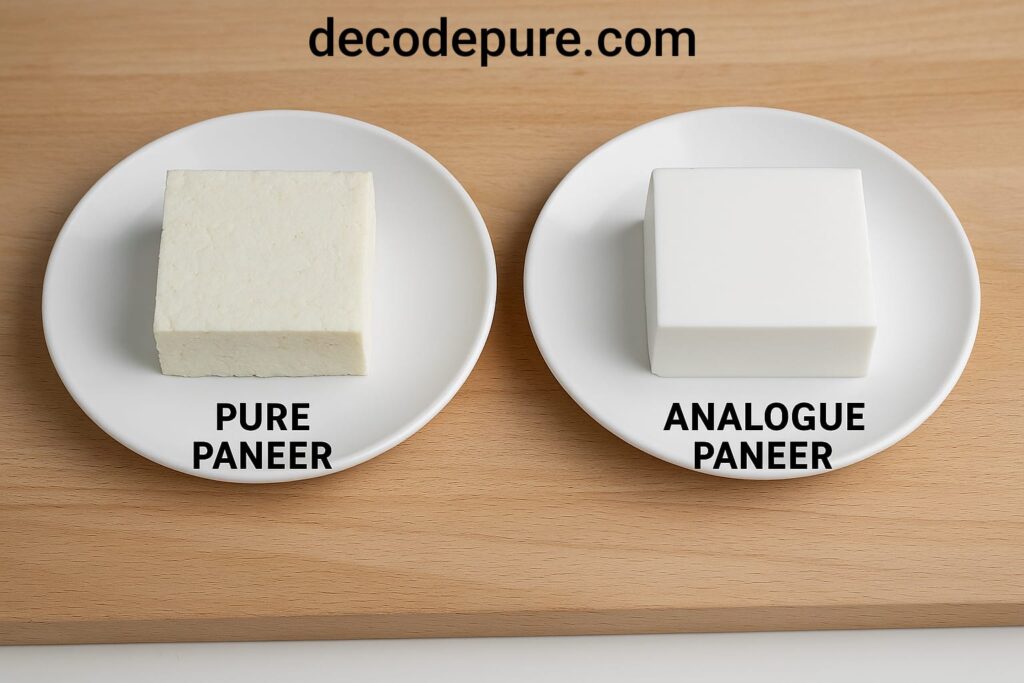Paneer is a most popular food item in many Indian’s kitchen. It is loved for it’s taste, excellent vegetarian protein source and versatility in cooking. But did you know that not all paneer are real, sold in market? It’s taste and look like similar but making process is different. Some shops and brands use cheap ingredients to make it. For long term consuming can create serious health problem.
In this post revels what’s really inside that white block. Breakdown their making process and how they affect our health, and how you can easily check, is it real or fake paneer.
Table of Contents
Ingredients matter
As a common man, we have no alternative way to verify which product is harmful and which is not. Only the ingredient list can help us in this regard. There is no other way.
So, before buying anything, be sure to check the ingredients list.
Real Paneer
Ingredients –
- Fresh full fat milk (cow or buffalo)
- Natural acid l(ike lemon juice, vinegar or citric acid)
Preparation –
- Heat the fresh milk in a clean vessel (avoid burning). Reduce the flame when start boiling.
- After that add lemon juice or vinegar slowly.
- The milk will being curdle, separating into curds (paneer) and whey.
- Turn off the heat and let it set for few minutes.
- Now strain it through a clean muslin cloth to remove the whey.
- Then rinse the collected paneer under cold water
- Press and set: place a weight on the top and let sit for 1-2 hours.
- Your fresh paneer is ready. Cut it into cubes and use it in your favourite dishes.
This process is so simple to produces pure and chemical free (no added starch, oils or preservatives) paneer.
Characteristic
- Soft, crumbly texture
- Milky aroma
- Browns evenly cooked
- Release whey when pressed
Health benefits
- high quality protein source: Ideal for vegetarians and fitness passionate. Paneer is rich in casein protein, which is helpful to build muscles, repair tissues.
- Paneer is rich in calcium, that’s supports strong bones and teeth.
- Pure paneer contains healthy fats and that’s very helpful for heart health.
- Real paneer is high in protein and low in carbohydrates, which helps to fat burning.
- Paneer is good source of phosphorus and magnesium, both are very helpful to improves digestion.
- Pure paneer provides essential nutrients like zinc, selenium and vit B, which is supports immune function.
- Real paneer is high in protein and low glycemic index, that is very much suitable for people with diabetes by preventing blood sugar spike.
All these benefits apply only to 100% pure paneer made from pure milk.

Fake Paneer
Fake paneer also known as ‘Analogue Paneer’
According to FSSAI The food safety and standards Authority of India (Amended in 2016) specify that –Products that do not use milk or milk solids as primary ingredient but resemble paneer must be labelled as “paneer analogue” or “analogue paneer.” They are not considered as real paneer.
Analogue paneer is not banned in India
Ingredients –
- Vegetable oil (palm oil, vanaspati oil)
- Starch and other emulsifires
- Synthetic milk or milk powder
- Chemical additives like detergent or washing soda.
Preparation –
- Milk powder is mixed with water and starch to simulate milk
- Then added vegetable oil (palm oil) for fat like consistency
- After that using acid (like citric acid or vinegar) for curdled
- The curds are filtered and cooled, and cut like real paneer
Characteristic
- Rubbery or overly smooth texture
- Chemical or sour smell
- Does not release any whey when pressed
Health Impact
- Palm oil, which are linked to raises LDL (bad cholesterol), Increase risk of heart disease, heart stroke, chronic inflammation.
- long term intake can cause kidney disease (CKD).
- Used detergents can cause fatty liver disease and liver inflammation.
- Detergents and starch irritate the digestive tract (bloating, cramps, vomiting, indigestion)
- Hormonal imbalance
- Cancer risk
- Continue intake fake paneer can weaken Immunity.
- Neurological effects in children.
Source: FSSAI’s milk Adulteration Survey (2018), ICMR – NIN (Indian Council of Medical Research – National Institute of Nutrition), Article from AIIMS, Delhi and Lacent Global Health.

How to Spot Fake Paneer
1. Texture test:
Real – Soft, crumbly and milky aroma.
Fake – Rubbery, overly smooth and chemical smell.
2. Iodine Test:
Take a piece of paneer and boil it and then let it cool. Now add few drops of iodine tincture. If it turns blue, then starch is present (fake paneer).
Note: If fake paneer is made without starch (e.g., synthetic milk made with detergents and oils only), the iodine not show a positive result.
3. Arhar Dal test:
Take a piece of paneer and boil it and then let it cool, add arhar dal powder. If it turns light red color, indicate presence of detergents or urea (fake paneer).
4. Label check:
Look for FSSAI certification and try to avoid products listing “analogue paneer” or “non dairy”
5. Price:
Real paneer: ₹ 400 – 450/kg
Fake paneer: ₹ 200-250/kg (low price)
This type of fake paneer is used in most of the sidewalks and small shops also restaurants in India. Here you can eat a lot of paneer at a very low price.
Reference: FSSAI DART (detect Adulteration with Rapid Test) booklet
FSSAI Guideline
- Products that do not use milk or milk solids as primary ingredient but resemble paneer must be labelled as “paneer analogue” or “analogue paneer.” They are not considered as real paneer.
- Fake paneer must be labelled as “analogue paneer.” (selling fake paneer as real is illegal punishable by fines.
- Selling analogue paneer is legal in India.
FSSAI allow analogue paneer for economic or dietary reasons, but strictly regulates labeling to protect consumer rights.
References:
- FSSAI – Food Safety and Standards (food products standards and food additives) Regulation, 2011 (Amended)
- News articles from The Hindu, TOI and FSSAI awareness campaings
- Hindustan times Report
- Indian Express Article
Summary
- Real paneer is contain high quality protein source, rich in calcium, healthy fats and that’s very helpful for heart health.
- In market, pure paneer must labelled as ‘Real Paneer’
- Analogue paneer ≠ Real paneer.
- Analogue paneer doesn’t made with real milk as primary ingredients.
- Analogue paneer contains harmful chemicals like palm oil, detergents, starch….etc (long term consuming can cause heart disease type problems).
- Selling ‘analogue paneer’ is legal in India.
Read More: Ice cream vs Frozen Desserts – What’s Safe and What’s Not?
What to do?
- Before buying must read the ingredients list. If labelled as ‘Analogue paneer” – try to avoid.
- Buy from trusted dairies.
- Paneer testing
- Make your on paneer in home.
Conclusion
paneer, once a symbol of nourishment and purity, is now often replaced with harmful chemicals and synthetic ingredients. Fake paneer or analogue paneer may look and taste like real paneer but for a long term consuming it can create major health problem.
By learning how to identify real paneer checking ingredients list and making informed choices you can protect your family from invisible toxins. Always check the ingredients list before buying anything. Mind it – ‘Analogue paneer’ means not ‘real paneer.’
I believe that buying anything shouldn’t be a guessing game. It’s time to we should start read labels and exploring healthier alternative.
Choose pure, choose wisely, stay healthy.
If you like this information, then be sure to rate the page. And join the WhatsApp channel to get notifications when there are new updates.


I’m Mehebub Alam Chowdhury, an M.Sc. Organic Chemistry student, and my mission with Decodepure is to simplify complex chemical ingredients in everyday products. With my knowledge of chemicals, I aim to help you make safer, healthier choices by breaking down product labels in an easy-to-understand way.










